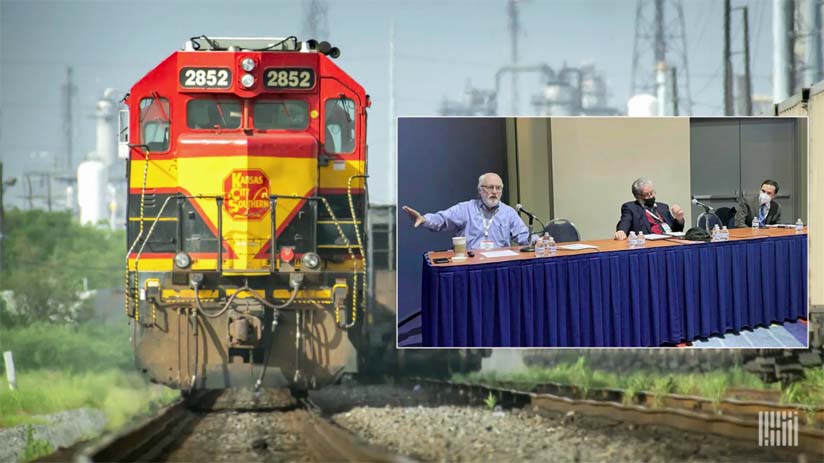
Washington District of Columbia USA - A panel on rail consolidation at the annual meeting of the Transportation Research Board here weighed
in on the proposed merger between CP and KCS, with one member suggesting the deal faces significant scrutiny despite success in the initial
stages.
With the merger now awaiting federal approval, where the CP/KCS combination fits on the spectrum of rail mergers was a key topic for the panel.
Rail consolidation, it was pointed out, is a sector of the business where little has happened after a flurry of consolidation in the 1990s.
One reason is the fallout from the failed BNSF-CN merger attempt of 2000, which resulted in new rules and guidelines that had restricted all but small
consolidations since then.
The CP/KCS merger is being allowed to proceed after the STB granted a waiver allowing pre-2001 rules to govern its consideration of the marriage.
But despite the waiver, Michael McBride, one of the panel members and an attorney with Van Ness Feldman, said he expects that the STB ultimately will be
"very sensitive" to what customers have to say about the combination.
"I think the board is going to be very attuned to service issues," McBride said.
Kansas City Southern is "going to need a lot of investment," McBride added, noting that the company has come under fire from STB members in the past
for insufficient investment.
"I'm not predicting they are going to disapprove this merger," McBridge said.
He added that both KCS and CP have "been sharp" in figuring out what the board wants to make the merger a reality.
One issue will be interchanges, McBride said.
There is only one interchange between KCS and CP, but interchanges with other railroads are "at the heart of the comments raised by
others."
While CP/KCS has said it is open to further interchanges between the combined railroad and other systems, McBride said CP and KCS management has said the
agreements must be on "commercially reasonable terms."
But the definition of that remains murky, McBride added.
Another member of the panel, Nicholas Powers, a principal with the Brattle Group, noted that rates of return for railroads are tightly linked to the size of a
railroad.
Even after a merger between CP and KCS, the consolidated railroad will continue to be the smallest class 1 railroad in North America.
At their current size, Powers said "both railroads have struggled to achieve revenue adequacy."
That appeared to be at the center of his presentation's title, "A Marriage of Necessity?"
Whether to permit a merger and the body of law behind antitrust policies ultimately can't be addressed in a vacuum, as antitrust law needs to take into account
the basic structure of a country's rail industry.
Putting the U.S. rail industry's structure into perspective was the job on the panel of Russell Pittman, an economist with the antitrust division of the U.S.
Department of Justice.
Railroads will always be considered a utility.
And as Pittman noted, how to regulate a utility is not standardized around the world.
"Economists generally have come out on the side of whether it is telecom, electricity, or the British and the Australians talking about water, the sector
should have two different parts," Pittman said.
One of those divisions should be a "competitive part," Pittman said.
The other is the "network part," where the competitors would conduct their business on that network's platform.
A problem with that approach, Pittman said, is that if the network operator remains as a competitor, "they will always discriminate."
That is one of the reasons why when AT&T was broken up in the early 1980s, it was permitted to operate the long-distance business but not the basic
underlying phone network.
For rail, that means the network is a "natural monopoly" but "the services part should be competitive."
Pittman said the rail sector in the U.S. has not operated precisely in that fashion.
It is an industry that is "vertically separated," with each railroad operating its network and competitors having no right to use that
infrastructure.
He added that the rail sector does have "parallel competition," which he said could involve imported steel being sent from Chicago to Los Angeles or
having it imported instead into Vancouver, British Columbia, for shipment to Montreal.
The ability to move the product by rail, and the cost, would be a factor in which port the importer would utilize.
Without declaring which system is better, Pittman compared the U.S. model to the approach taken in the EU.
Railroads there have access to the network of rails, which he said was "grudgingly accepted as an alternative to full vertical separation," like in
the U.S. and Canada.
But in the U.S., Pittman said, "they can tell anybody they want that you can't use the tracks."
That can only change if there is an agreement between railroads, which he described as "fairly common."
While vertical separation between the network and the operators does have the advantage of third-party access, Pittman said he saw one key flaw in it, capital
investment.
In the European system, which Pittman described as "horizontal," governments are responsible for maintaining the track network.
And Pittman described governments as "unreliable funders of railways," with other spending choices often taking priority.
"The government-owned track tends to be worn out along with the rolling stock," he said.
"Attracting private investment has been a real strength of the Americas option," Pittman said.
But he also noted a key drawback to the U.S. system, captive customers with no other options such as trucks or barges.
That makes up about 20 to 25 percent of the market, according to Pittman.
John Kingston.
(there was no image with original article)
(usually because it's been seen before)
provisions in Section 29 of the Canadian
Copyright Modernization Act.
